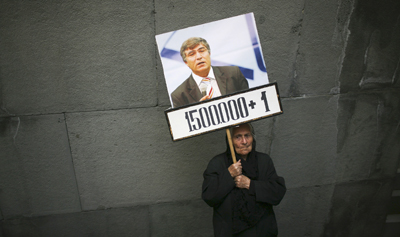There’s a policeman on duty these days in the lobby of the elegant apartment building that houses Agos and a receptionist behind security glass buzzes you in to the newspaper’s cluttered offices. That’s about the only indication that the outspoken Turkish-Armenian editor whom I interviewed here in Istanbul in 2006 was assassinated outside the front door a year later.
Hrant Dink’s murder by a provincial teenaged gunman was a watershed for Turkish journalism. Many journalists had been killed in the Kurdish conflict in the 1990s in the south and southeast of the country. But Dink’s shooting in broad daylight on a fashionable boulevard in the heart of the nation’s media capital shocked and angered the liberal and media establishment.
That outrage has not impelled prosecutors to bring the Dink family full justice. Many journalists and colleagues of Dink believe the investigation into his January 19, 2007, murder has netted only the small fry. The masterminds, whom they believe to be ultranationalists in the military and security services, are still free.
“We know there is evidence that a lot of police and soldiers are involved in the assassination,” said Rober Koptaş, a soft-spoken former Agos reporter who became editor-in-chief of the weekly last year.
Koptaş linked the killing to “Ergenekon,” an alleged underground network of military officers and bureaucrats unmasked in April 2007 and accused of plotting to overthrow the moderate Islamist government of Prime Minister Recep Tayyip Erdogan, whom they see as a threat to a secular Turkey. More than 500 people have been detained in some 18 waves of arrests since then, and the affair has come to dominate Turkish political life.
Koptaş 33, believes Ergenekon conspirators prepared the ground for eliminating Dink by building popular sentiment against him through sympathizers in the media years before the murder. Dink was a controversial figure in any case because he challenged Turkey’s historical narrative about the mass killings and expulsion of Armenians in World War I, and angered ultranationalists with some of his writing about their icon, modern Turkey’s founder Mustafa Kemal Ataturk. He received torrents of hate mail and death threats, and on several occasions protesters blocked the entrance to the Agos office. He was the frequent target of nationalist prosecutors who brought cases against him under Turkey’s arcane defamation statutes, including three prosecutions for “denigrating Turkishness.”
“Somewhere in the state, some officers, some people, came together and planned to kill him…before killing him they opened some cases, denigrating Turkishness, etc., and they forced some columnists to report against him,” Koptaş said.
“We are getting nowhere,” Koptaş said of the quest for justice. “Because the trial is only limited to those three or four, let’s say, children, youngsters, from Trabzon and there is no any real investigation about state officers whether civilian or military.”
Koptaş was speaking shortly before a juvenile court sentenced Ogün Samast to 22 years and 10 months in prison for pre-meditated murder. Samast, a native of the Black Sea city of Trabzon, was barely 17 years old when he shot Dink. Two others suspected of involvement in the murder plot, Yasin Hayal and Erhan Tuncel are being tried in adult criminal court.
The day after the July 25 sentence was handed down, a lawyer for the Dink family echoed Koptaş’s frustration with the investigation’s failure to arrest the masterminds. “Hrant Dink was watched very closely by the state and he was killed by persons who again were very closely watched by the state,” Fethiye Çetin told a press conference in Istanbul. “Everything is pointing to state institutions. It is blatantly obvious,” she added.
The advocacy group Friends of Hrant Dink calls the answers it has received from the government about the lack of progress in the murder inquiry “not serious.” Turkish President Abdullah Gül has, however, ordered the State Supervisory Council to investigate the killing.
“Yes, there is a presidential committee looking into this,” Koptaş acknowledges. “But we are not hopeful… Four and half years later and we saw nothing. There is no progress. And even we have a decision of the European Court of Human Rights punishing Turkey about that but nothing changed.”
Dink’s colleagues accuse the authorities, particularly in Istanbul, of failing to heed warnings from intelligence services of a credible threat to Dink’s life. They also point to numerous shortcomings in the investigation. Last month, however, a Trabzon court convicted six of eight officials accused of negligence over the prevention of the murder and sentenced Trabzon army commander Col. Ali Öz and army intelligence unit director Capt. Metin Yıldız to six months in prison. They are appealing the conviction.
Asked why the murder probe was not making more progress, Koptaş gave two reasons. First he believed investigators were now primarily interested in the Ergenekon coup plot itself rather than the Dink assassination that preceded it. Second, he claimed that some senior police officials who might be implicated in the Dink case were helping with the Ergenekon inquiry and so were not being pursued.
Koptaş said Agos, which has a circulation of 5,000, is pressing on with Dink’s work and serving Istanbul’s 60,000 Armenians. He says prosecutors have left the paper in peace since the murder and it now prints the controversial term “genocide” to describe the Armenian killings–something that would have definitely resulted in a prosecution previously. Dink used to receive about five threatening or hateful emails a day. Now the paper gets about five a year, he said.
Despite the paper’s success the lack of justice hangs over it like a cloud. Koptaş fears that the case could fade from public consciousness, eclipsed by Ergenekon.
“The assassination is like fading away because it’s not important,” he said. “The important thing is Ergenekon, the important thing is the political struggle…the case is not touching the mind or heart because the victim is Armenian. It is a pity for all of us for Turks and Armenians.”
